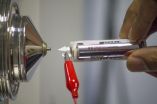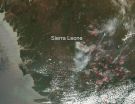(Press-News.org) WEST LAFAYETTE, Ind. — Nanotechnology is advancing tools likened to Star Trek's "tricorder" that perform on-the-spot chemical analysis for a range of applications including medical testing, explosives detection and food safety.
Researchers found that when paper used to collect a sample was coated with carbon nanotubes, the voltage required was 1,000 times reduced, the signal was sharpened and the equipment was able to capture far more delicate molecules.
A team of researchers from Purdue University and the Indian Institute of Technology Madras performed the study, which is detailed in a designated "very important paper" by the journal Angewandte Chemie.
"This is a big step in our efforts to create miniature, handheld mass spectrometers for the field," said R. Graham Cooks, Purdue's Henry B. Hass Distinguished Professor of Chemistry. "The dramatic decrease in power required means a reduction in battery size and cost to perform the experiments. The entire system is becoming lighter and cheaper, which brings it that much closer to being viable for easy, widespread use."
Cooks and Thalappil Pradeep, a professor of chemistry at the Indian Institute of Technology Madras, Chennai, led the research.
"Taking science to the people is what is most important," Pradeep said. "Mass spectrometry is a fantastic tool, but it is not yet on every physician's table or in the pocket of agricultural inspectors and security guards. Great techniques have been developed, but we need to hone them into tools that are affordable, can be efficiently manufactured and easily used."
The National Science Foundation-funded study used an analysis technique developed by Cooks and his colleagues called PaperSpray™ ionization. The technique relies on a sample obtained by wiping an object or placing a drop of liquid on paper wet with a solvent to capture residues from the object's surface. A small triangle is then cut from the paper and placed on a special attachment of the mass spectrometer where voltage is applied. The voltage creates an electric field that turns the mixture of solvent and residues into fine droplets containing ionized molecules that pop off and are vacuumed into the mass spectrometer for analysis. The mass spectrometer then identifies the sample's ionized molecules by their mass.
The technique depends on a strong electric field and the nanotubes act like tiny antennas that create a strong electric field from a very small voltage. One volt over a few nanometers creates an electric field equivalent to 10 million volts over a centimeter, Pradeep said.
"The trick was to isolate these tiny, nanoscale antennae and keep them from bundling together because individual nanotubes must project out of the paper," he said. "The carbon nanotubes work well and can be dispersed in water and applied on suitable substrates."
The Nano Mission of the Government of India supported the research at the Indian Institute of Technology Madras and graduate students Rahul Narayanan and Depanjan Sarkar performed the experiments.
In addition to reducing the size of the battery required and energy cost to run the tests, the new technique also simplified the analysis by nearly eliminating background noise, Cooks said.
"Under these conditions, the analysis is nearly noise free and a sharp, clear signal of the sample is delivered," he said. "We don't know why this is – why background molecules that surround us in the air or from within the equipment aren't being ionized and entering into the analysis. It's a puzzling, but pleasant surprise."
The reduced voltage required also makes the method gentler than the standard PaperSpray™ ionization techniques.
"It is a very soft method," Cooks said. "Fragile molecules and complexes are able to hold together here when they otherwise wouldn't. This could lead to other potential applications."
The team plans to investigate the mechanisms behind the reduction in background noise and potential applications of the gentle method, but the most promising aspect of the new technique is its potential to miniaturize the mass spectrometry system, Cooks said.
Cooks is a pioneer in mass spectrometry and has worked for years to take mass spectrometers from the size of a car to that of a shoebox.
Early in his career he developed ambient ionization techniques that allowed testing to be done in the air or directly on a surface in its natural environment, as opposed to conventional mass spectrometry techniques that required chemical separations, manipulations of samples and containment in a vacuum chamber for ionization and analysis. Ambient ionization paved the way for faster, more portable mass spectrometry devices that could be used outside of a laboratory.
Cooks and his collaborator Zheng Ouyang, Purdue associate professor of biomedical engineering and electrical and computer engineering, have created several generations of miniature mass spectrometers. They recently published papers on the latest generation, the "Mini 12," in the journal Analytical Chemistry.
Cooks and his team have fine-tuned the tools for use in molecular imaging for cancer diagnostics and surgery; therapeutic drug monitoring; testing for biomarkers in urine; and the identification of food-borne pathogens, bacteria, pesticides and explosives residues.
Cooks is associated with several Purdue research centers, including Bindley Bioscience Center, the Purdue Center for Cancer Research and the Center for Analytical Instrumentation Development.
INFORMATION:
Writer: Elizabeth K. Gardner, 317-698-9879, ekgardner@purdue.edu
Sources: R. Graham Cooks, 765-494-5263, cooks@purdue.edu
Thalappil Pradeep, pradeep@iitm.ac.in
Related websites:
Miniature Mass Spectrometers at Purdue
Cooks' Aston Labs Research
Pradeep research group
ABSTRACT
Molecular Ionization from Carbon Nanotube Paper
Rahul Narayanan, Depanjan Sarkar, R. Graham Cooks and Thalappil Pradeep
Ambient ionization is achieved by spraying from a carbon nanotube (CNT) impregnated paper surface under the influence of small voltages (≥3V). Organic molecules give simple high quality mass spectra without fragmentation in the positive or negative ion modes. Conventional field ionization is ruled out and field emission of microdroplets is indicated. Microscopic examination of the CNT paper confirms the nanoscale features at the modified paper surface are responsible for high electric fields. Raman spectra imply substantial current flows in the nanotubes. Analytical performance is shown with volatile and non-volatile compounds and a variety of matrices.
Nanotube coating helps shrink mass spectrometers
2014-03-25
ELSE PRESS RELEASES FROM THIS DATE:
Model predicts blood glucose levels 30 minutes later
2014-03-25
A mathematical model created by Penn State researchers can predict with more than 90 percent accuracy the blood glucose levels of individuals with type 1 diabetes up to 30 minutes in advance of imminent changes in their levels -- plenty of time to take preventative action.
"Many people with type 1 diabetes use continuous glucose monitors, which examine the fluid underneath the skin," said Peter Molenaar, Distinguished Professor of Human Development and Family Studies and of psychology. "But the glucose levels under the skin trail blood glucose levels from anywhere between ...
NASA satellite sees wind shear whipping Tropical Cyclone Gillian
2014-03-25
A visible image from NASA's Aqua satellite provides a clear picture that wind shear is responsible for weakening the once mighty Tropical Cyclone Gillian from hurricane to tropical storm strength.
When NASA's Aqua satellite flew over Gillian on March 25 at 06:30 UTC/2:30 a.m. EDT, the Moderate Resolution Imaging Spectroradiometer or MODIS instrument took a visible picture of the storm. That image showed that wind shear has pushed clouds and showers away from the center as the storm weakened to a tropical storm.
In the MODIS image, the center of Gillian's circulation ...
Haynes is first to identify cellular patterns of contraction in human hearts
2014-03-25
LEXINGTON, Ky. (March 19, 2014) — When Premi Haynes was growing up in Pune, India, she attended Stella Maris High School, an English language convent school founded by Swiss nuns. Her second grade singing class used a book of English songs. One of the songs was "My Old Kentucky Home." At that time, Haynes had never heard of Kentucky, had no idea where it was, and had no particular ambition to go there.
Some 20 years and a twist of fate later, on March 19 Haynes successfully defended her Ph.D. thesis in physiology at the University of Kentucky, where she's made a significant ...
Agricultural fires across Sierra Leone
2014-03-25
Marked in red, hundreds of land use fires burn in the fields across Sierra Leone. Most fires in this region are deliberately set for a variety of reasons, including slash and burn agriculture. When a plot of land becomes exhausted, farmers shift cultivation to another plot where they cut the trees and brush at the beginning of the dry season in January and February. Once the dead plant material has dried, they set fire to it. Such fires peak in March and April right before farming season begins.
From space, MODIS detects thermal anomalies, including fires, flares, and ...
Sensing gravity with acid
2014-03-25
WOODS HOLE, Mass.—While probing how organisms sense gravity and acceleration, scientists at the Marine Biological Laboratory (MBL) and the University of Utah uncovered evidence that acid (proton concentration) plays a key role in communication between neurons. The surprising discovery is reported this week in Proceedings of the National Academy of Sciences.
The team, led by the late MBL senior scientist Stephen M. Highstein, discovered that sensory cells in the inner ear continuously transmit information on orientation of the head relative to gravity and low-frequency ...
Understanding plant-soil interaction could lead to new ways to combat weeds
2014-03-25
URBANA, Ill. – Using high-powered DNA-based tools, a recent study at the University of Illinois identified soil microbes that negatively affect ragweed and provided a new understanding of the complex relationships going on beneath the soil surface between plants and microorganisms.
"Plant scientists have been studying plant-soil feedback for decades," said U of I microbial ecologist Tony Yannarell. "Some microbes are famous for their ability to change the soil, such as the microbes that are associated with legumes—we knew about those bacteria. But now we have the ability ...
Patient safety merits new review for modified medical devices, physician says
2014-03-25
For patient safety, the U.S. Food and Drug Administration (FDA) should require that clinical data be submitted as part of a more rigorous re-evaluation of medical devices that are modified after approval, according to UC San Francisco physician scientists in a commentary published online March 24, 2014 in the Annals of Internal Medicine. According to authors Rita Redberg, MD, UCSF professor of medicine, and UCSF second-year medical student Sarah Zheng, such a requirement could prevent deaths due to insufficiently tested device modifications.
"The need for rapid approval ...
USF study: Blood-brain barrier repair after stroke may prevent chronic brain deficits
2014-03-25
TAMPA, Fla. (March 25, 2014) – Following ischemic stroke, the integrity of the blood-brain barrier (BBB), which prevents harmful substances such as inflammatory molecules from entering the brain, can be impaired in cerebral areas distant from initial ischemic insult. This disruptive condition, known as diaschisis, can lead to chronic post-stroke deficits, University of South Florida researchers report.
In experiments using laboratory rats modeling ischemic stroke, USF investigators studied the consequences of the compromised BBB at the chronic post-stroke stage. Their ...
NASA sees remnants of TD04W dissipating in South China Sea
2014-03-25
The remnants of Tropical Depression 04W moved away from Palawan and into the South China Sea on March 25 as NASA's TRMM satellite passed overhead.
NASA's Tropical Rainfall Measuring Mission or TRMM satellite passed over the South China Sea on March 25 at 02:56 UTC/March 25 at 10:56 p.m. EDT and gathered data on rainfall rates occurring in the remnants of TD04W. The image showed that the rainfall associated with the storm had moved away from Palawan and were only falling over the South China Sea. TRMM's Precipitation Radar instrument showed isolated areas where rain was ...
Validation study results show method can replace live animals in skin allergy tests
2014-03-25
Phoenix — Guinea pigs and mice can be replaced with a non-animal skin sensitization method that uses a human-derived skin model, according to a study presented today by the PETA International Science Consortium, Ltd., at the Society of Toxicology's annual meeting.
Recent results show that Cyprotex's in vitro skin sensitization assay SenCeeTox® can correctly identify chemicals that cause an allergic response in humans and, unlike many other methods, can predict the potency of the response. This non-animal method uses a three-dimensional, human-derived skin model that accurately ...






